


 |
 |
 |
Shaun Kellogg, Sherry Booth, and Kevin Oliver
North Carolina State University, United States
A recent phenomenon in the MOOC space has been the development of courses tailored to educators serving in K-12 settings. MOOCs, particularly as a form of educator professional development, face a number of challenges. Academics, as well as pundits from traditional and new media, have raised a number of concerns about MOOCs, including the lack of instructional and social supports. It is an assumption of this study that challenges arising form this problem of scale can be addressed by leveraging these massive numbers to develop robust online learning communities. This mixed-methods case study addresses critical gaps in the literature and issues of peer support in MOOCs through an examination of the characteristics, mechanisms, and outcomes of peer networks. Findings from this study demonstrate that even with technology as basic as a discussion forum, MOOCs can be leveraged to foster these networks and facilitate peer-supported learning. Although this study was limited to two unique cases along the wide spectrum of MOOCs, the methods applied provide other researchers with an approach for better understanding the dynamic process of peer supported learning in MOOCs.
Keywords: MOOC; social network analysis; online learning; communities of practice
MOOCs, or massively open online courses, have gained extensive media attention for their vast enrollment numbers and the alliance of prestigious universities collectively offering free courses to learners worldwide. Though MOOCs have primarily consisted of undergraduate level courses at these respective colleges, early reports on participant demographics suggests that a typical MOOC ‘student’ already holds a bachelor’s or master’s degree and is employed full- or part-time (Balch, 2013; Belanger & Thorton, 2013; Kizilcec & Piech, 2013; University of Edinburgh, 2013). For many, MOOCs are filling the role of continuous education and ongoing professional development, serving to satisfy personal intellectual curiosity or enhance the workplace skills of post-graduates.
A recent development in the MOOC space has been the growing number of courses tailored to educators serving in K-12 settings. In April, 2013, the Friday Institute for Educational Innovation at North Carolina State University, in partnership with the Alliance for Excellent Education, launched MOOC-Ed.org along with its first course aimed at supporting school technology leaders (Kleiman, Wolf, & Frye, 2013). Shortly after, Coursera announced a partnership with leading schools of education and cultural institutions, to open up a series of training and development courses for teachers worldwide (Empson, 2013). Education leaders, such as former governor of West Virginia and President of the Alliance for Excellent Education Bob Wise (2013), see MOOCs as a means for schools and districts facing slashed budgets and increasing demands to provide personalized professional development at a fraction of the cost of traditional models. MOOCs as a new model of online professional development present new opportunities and pose new challenges. MOOCs typically provide little or no instructional support beyond the prepared videos and course materials posted by professors and staff. Due to their scale, even MOOCs with active instructors make it impossible to provide the level of instructional feedback and support that would be expected in smaller face-to-face or conventional online course settings.
This problem of scale, however, presents a unique opportunity for social networking and the development of peer support networks to fill this instructional void. In a report commissioned by the Canadian government to study the implications of MOOCs for the digital economy, McAuley, Steward, Siemens, and Cormier (2010) noted that MOOCs have the potential to “model and build collaborative networks of unprecedented size that transcend time and space” and the “network ties created between people during a MOOC have the potential to continue as sustainable and relevant personal and professional connections beyond the boundaries of the course itself” (p. 35). This case study adopts a social network perspective in order to investigate peer interaction and support in two MOOCs designed for the professional development of K-12 educators (MOOC-Eds).
It is only in the past couple of decades that network thinking has gained considerable attention in academia, as noted by Borgatti and Foster (2003) in the exponential growth of publications on “social networks.” Research in education has followed a similar trend, which Mcfarland, Diehl, and Rawlings (2011) attribute “not only to a growing awareness of networks brought on by the popularity of social networking sites like Facebook and Twitter, but also as a result of statistical breakthroughs and substantial increases in computing power” (p. 88). While social learning theories such as social cognitive theory and social constructivism have become an accepted part of our knowledge base for understanding the learning process (Bandura & McClelland, 1977; Grusec, 1992; Wu, Tennyson, & Hsia, 2010), educational researchers have noted the limitations of these theories in the digital age (Bell, 2011). In their theory of connectivism, Siemens (2005) has described learning as a process of network formation, with connections being key to networked learning, while Downes (2009) asserts that knowledge consists of the network of connections formed from experience and interactions with a knowing community.
The process of network formation described by Siemens, specifically the development of peer-support networks, is of primary interest to this study. In their review of the literature, Rivera, Soderstrom, and Uzzi (2010) classify these processes into three broad mechanisms: 1) assortative mechanisms, 2) relational mechanisms, and 3) proximity mechanisms. Assortative mechanisms theorize that the creation, persistence, and dissolution of ties between individuals are “outcomes that rely on the compatibility and complementarity of actors’ attributes” (p. 94). One assortative mechanism is homophily, or the tendency for individuals in the physical and virtual world to show a preference for interacting with others who share similar characteristics such as gender, age, ethnicity, and education level. Although this social phenomenon and its effects have been studied across a variety of offline educational settings (Burgess, Sanderson, & Umaña-Aponte, 2011; M. H. Jones, Alexander, & David, 2010; Rocca & Mccroskey, 1999), our understanding in online learning settings is limited (Yuan & Gay, 2006). Stepanyan, Borau, and Ullrich (2010) examined homophily and popularity effects among students utilizing Twitter as part of an English language course at a university in Shanghai and found a preference among students to “follow” and communicate with other students with similar academic grades histories. Homophily has also been examined in the context of school reform. Penuel et al. (2010) examined the impact of a school-wide reform effort to improve teacher collaboration around literacy instruction at two elementary schools. The researchers found that in the school that had not succeeded in enacting significant reforms, there continued to be a fractured social network where subgroups were defined by homophily, while in the successful school they found “a cohesive advice network with subgroups aligned to the formal organization of the school into grade-level teams… and a coach who played a central role within the advice network” (p. 63).
Relational mechanisms emphasize the impact that the network’s structure has on the formation of ties and encompasses network effects such as reciprocity, transitivity and actor prestige. For example, reciprocity (e.g., communications involving back-and-forth exchange) has been described as one of the defining attributes of any network, real or virtual (Aviv, Erlich, Ravid, & Trotter, 2008). However, evidence for reciprocity as a mechanism in online social spaces, that is knowledge exchanges between two parties that are mutual and perceived as fair by both parties, is mixed. Wang and Noe (2010) reported on the relationship between the norm of reciprocity and knowledge sharing in the context of communities of practice and noted that a third party rather than the original recipient often reciprocates an individual’s knowledge sharing in communities of practice. Chiu et al. (2006), on the other hand, investigated knowledge sharing in an IT-oriented professional learning community in Taiwan and found that the degree to which participants’ felt a norm of reciprocity was positively associated with individuals’ frequency of their sharing knowledge, though not the quality of their postings. These mixed results reflect those of other studies of network interaction in online virtual communities (C.-J. Chen & Hung, 2010; Hew & Hara, 2007; C. Wang & Lai, 2006). The evidence suggests a pattern of generalized exchange, which Cropanzano and Mitchell (2005) describe as a process of “group gain”:
[B]enefits are put into a single common “pot” and individuals take what they need from this common pool regardless of their particular contribution. Likewise, they contribute to this cache when they are able. Notice that the exchange is not directly transacted from individual to individual. Rather, all things are held in common. Group gain does not involve dyadic or interpersonal exchanges; rather, all things are held in common. (p. 879)
Research also suggests that actors who are more spatially proximate, that is, live or work near one another, are more likely to form social ties. These mechanisms have been found to shape social networks in both physical and online settings. Barab, MaKinster, and Scheckler (2003) noted that proximity in terms of physical location influenced whether members of work teams collaborated with each other, even when team members were spread out over geographic distances and were working together through online collaborative tools. Huang, Shen, and Contractor (2013) reported similar findings in terms of proximity among members of gaming communities, while Yuan and Gay (2006) found that proximity as well as other shared sociodemographic characteristics influenced network ties even among individuals who have only interacted through computer-mediated communication.
Finally, social network theory posits that the structure of social relations can facilitate or inhibit outcomes for individuals and has been used to explain a wide variety of phenomena in the social sciences (S. Borgatti, Mehra, Brass, & Labianca, 2009). In online learning settings such as higher education, studies have found relationships between network measures and academic outcomes like knowledge construction (Aviv, Erlich, Ravid, & Geva, 2003; Rossi, 2010), academic performance (Cho, Gay, Davidson, & Ingraffea, 2007; Russo & Koesten, 2005), and positive dispositions toward the learning experience (Dawson, 2008; Lowes, Lin, & Wang, 2007). The process of knowledge co-construction in online learning spaces in particular has received considerable attention by network researchers in education (Aviv et al., 2003; Heo, Lim, & Kim, 2010; S. Wang & Noe, 2010; Zheng & Spires, 2012). Wang and Noe (2010) examined the relationship between knowledge construction and learners’ positions at the core, core-periphery, and periphery of the network and found that the closer students are to the “core” of a network, the more active they are in the “information-sharing” and “negotiation of meaning” levels of knowledge building.
Although still in its infancy, the MOOC literature to date has explored topics as diverse as self-regulated learning (Littlejohn, 2013), user attributes and behaviors (Aiken, Lin, Schatz, & Caballero, 2013; Belanger & Thorton, 2013; Breslow et al., 2013; Deboer, Stump, Pritchard, Seaton, & Breslow, 2013), completion rates (Clow, 2013), and learning analytics (Fournier, Kop, Sitlia, & others, 2011; Seaton, Bergner, Chuang, Mitros, & Pritchard, 2013; Sinha, 2012). A handful of studies have even addressed learning as a social process (Cabiria, 2008; Levy, 2011; Mak, Williams, & Mackness, 2010; Viswanathan, 2012). In this review, however, only one study proposed research to explore networked learning by “experimenting with social network analysis to see if it yields findings about the nature and longevity of group formation” (Breslow et al., 2013, p. 23).
The above review of the literature highlights the potential for network thinking to expand our understanding of the learning process as a social endeavor. However, there is a need for more research in the field of education, and online learning in particular, that explores mechanisms shaping network processes. In addition, studies that have examined network outcomes such as knowledge construction have drawn their data from college-level online courses where participation is tied to course grades and discussion forums are highly structured by an instructor. This study aims to address these gaps in the MOOC literature through social network analysis (SNA) and qualitative methods that explore the processes and product of peer support networks in two MOOC-Eds.
This study employs a mixed-method case-study design. The case study approach is well-suited for studying emerging complex social phenomenon in a natural setting in which the investigator has little or no control (Yin, 2009).
This study is framed by three primary research questions related to peer supported learning:
RQ1. What are the patterns of peer interaction and the structure of peer networks that emerge over the course of a MOOC-Ed?
RQ2. To what extent do participant and network attributes (e.g., homophily, reciprocity, transitivity) account for the structure of these networks?
RQ3. To what extent do these networks result in the co-construction of new knowledge?
Yin (2009) states that an important component of case study research is the development of theoretical propositions used to guide the study. Each proposition, Yin notes, directs attention to something that should be examined within the study. One aim of this study is to find commonalities that describe educator interaction patterns within MOOCs and identify mechanisms that are predictive of social ties. Based on the theoretical framework and the above literature review, three theoretical propositions for network processes are also put forth below.
Early findings in network research have also noted tendencies for a small proportion of individuals in social networks to have a disproportionate number of social ties (Rivera et al., 2010). These types of networks are commonly referred to as scale- free networks and their degree distribution, that is, the number of ties each actor in the network has, follow a power law distribution rather than a normal curve. This skew in the number of ties has been noted by Wenger who asserts that CoPs typically consist of a small core group of active participants who participate quite frequently and assume community leadership; a small active group of members who participate regularly but not as frequently as the core group; and a large portion of members, peripheral participants, who rarely participate (Wenger et al., 2002). Findings from the literature suggest this core-periphery structure is common among large online communities, including online learning communities.
P1. The social network is likely to be characterized by a small core of highly connected individuals, with a large proportion of actors surrounding the periphery of the core.
Researchers have suggested that reciprocity is one of the defining attributes of any network, real or virtual, and that an individual forms a tie with someone who has already related to him or her, or with someone who is a promising resource and will probably reciprocate (Aviv et al., 2008). However, evidence for reciprocity, that is, knowledge exchanges between two actors that are mutual, as a mechanism in non-education related online networks is mixed. Although Hakkinen and Jarvela (2006) found evidence of reciprocity among pre-service teachers in a web-based course, Aviv et al. (2008) hypothesized that in distance learning networks, levels of reciprocity would be no greater than would be expected by chance due to limited face-to-face contact and discussions being limited in scope and time. To their surprise, they found that in all 95 internet-based networks formed in Open University of Israel courses, reciprocity was observed beyond what would be expected by chance in all networks. Thus, the following proposition is put forth:
P2. Reciprocity will have a positive effect on tie formation in MOOC-Eds.
Finally, assortative mechanisms speculate that the creation, persistence, and dissolution of social ties are all outcomes that rely on the compatibility and complementarity of actors’ attributes, while proximity mechanisms suggests that actors who are closer geographically are also more likely to form a tie (Rivera et al., 2010). As detailed earlier, network researchers have provided evidence of homophily and proximity in the formation of network ties, even in academic settings where similarity is not a necessary condition for learning, and where learners have only interacted online. As new ties are more likely to form between individuals who share similar characteristics, homophily and geographical proximity are likely to play an important role, especially in a MOOC environment where participants are unlikely to know each other and are therefore unlikely to have pre-existing ties. It is expected, therefore, that there will be more ties than would be expected by chance between participants of the same gender, educational background, similar educational background, in similar educational roles (e.g., principals), and with similar years of experience.
P3: Shared personal and professional attributes (homophily) and differences in experience (heterophily) will increase the likelihood of a network tie.
In the spring of 2013, The Friday Institute launched the MOOC-Ed Initiative (mooc-ed.org) to explore the potential of delivering personalized, high-quality professional development to educators at scale (Kleiman et al., 2013). In collaboration with the Alliance for Excellent Education, launched this initiative with a 6-week pilot course called Planning for the Digital Learning Transition in K-12 Schools (DLT), which was offered again in September 2013. This course was designed to help school and district leaders plan and implement K-12 digital learning initiatives. A second course, Mathematics Learning Trajectories: Equipartitioning (EQP), ran in August 2013. It introduced elementary- and middle-grades educators to learning trajectories as a framework for interpreting and implementing the Common Core State Standards. Among the core design principles of MOOC-Eds are collaboration and peer-supported learning. Courses combine Google Course Builder with Vanilla Forums and Google Hangouts on Air to facilitate these learning activities.
To address the above research questions, data came from two primary sources.
MOOC-Ed registration form. All participants complete a registration form for each MOOC-Ed course. The registration form consists of self-reported demographic data, including information related to their professional role and work setting, years of experience in education, and personal learning goals.
MOOC-Ed discussion forums. All peer interaction, including peer discussion, feedback, and reactions (e.g., likes), take place within the forum area of MOOC-Eds, which are powered by Vanilla Forums. To build peer support networks for network analyses, a MySQL file was downloaded for the two fall DLT and EQP courses. Separate database tables containing postings and comments were joined, or combined, to create a single network edge list (e.g., who interacted with who), which included participant IDs, timestamps, discussion text and other attributes. These data are merged with participant information from registration forms to create a single network analysis data file containing both peer interaction and participant attributes for qualitative coding and later import into SNA software. Because of the specific focus on peer supported learning, postings to or from course facilitators and staff were removed from the data set. Finally, analyses described below exclude more passive forms of interactions (i.e., read and reaction logs), and include only postings among peers.
This study employed a mixed-methods approach that uses both SNA with qualitative methods to address the proposed research questions. SNA is a research methodology that seeks to identify underlying patterns of social relations based on the way actors are connected with each other (Scott, 2000; Wasserman & Faust, 1994). Specifically, SNA involves network metrics at the global level (e.g., density, reciprocity, degree distribution) and the individual level (e.g., centrality, node degree). In this study, SNA was used to measure and visualize patterns of interaction. NodeXL, a freely available template for Microsoft Excel, was used to calculate basic SNA metrics and create visualizations. In addition, two specialized network techniques were employed to address the first two research questions: blockmodeling and exponential random graph models (ERGMs).
To further examine patterns of peer support, actors in the network were categorized into distinct mutually exclusive partitions using the core-periphery and regular equivalence functions of UCINET. The former used the CORR algorithm to divide the network into actors that are part of a densely connected subgroup, or “core”, from those that are part of the sparsely connected periphery (S. P. Borgatti, Everett, & Freeman, 2002). The latter employs the REGE algorithm to partition actors in the network based on the similarity of their ties to others with similar ties. On the importance of regular equivalence, Hanneman and Riddle (2005) note that “it provides a method for identifying “roles” from the patterns of ties present in a network, rather than relying solely on the attributes of actors to define social roles.” In essence, blockmodeling provides a systematic way for categorizing educators based on the ways in which they interacted with peers.
The exponential family of random graph models (ERGM; also known as p* models) provide a statistical approach to network modeling that addresses the complex dependencies within networks. ERGMs were used to model the effects of individual and network attributes on support ties formed between participants. ERGMs predict network ties and determine the statistical likelihood of a given network structure, based on an assumed dependency structure, the attributes of the individuals (e.g., gender, popularity, location, previous ties) and prior states of the network. This study followed the procedure for constructing ERMGs described by Robins et al. (2007) and used statnet, an open-source suite of software packages for R to perform this modeling (Handcock, Hunter, Butts, Goodreau, & Morris, 2008). One common problem with model specification, known as degeneracy, is that parameter estimates can produce networks that are implausible (Snijders, 2011). To prevent model degeneracy, this study used the fixed version of the geometrically weighted terms for popularity spread (gwidegree) and transitivity (gwesp), with lambda set to one (Hunter, 2007; Robins et al., 2007). One limitation of this study is that models that incorporated parameters to assess transitivity, even geometrically weighted ones, still resulted in degeneracy and as a result this relational mechanism could not be modeled.
Finally, this study adopted the interaction analysis model (IAM) to assess the extent to which the interactions among educators resulted in the co-construction of knowledge (Gunawardena, Lowe, & Anderson, 1997). Two independent coders participated in a training session in which they were introduced to the content analysis coding scheme, and an initial codebook with examples from the literature. The session consisted of joint coding by the two coders and the lead author and involved independently coding and then discussing a subset of discussion threads selected by stratified random sampling based on length of discussion threads. All discussions were coded by the two primary coders, and in cases of disagreement, the third coder would assign a code. Discussions in which two out of three coders could not agree were excluded from the analysis. In total, 655 (40% of total) peer postings from DLT, and 232 (31%) from EQP were included in the analysis.
Network level statistics provide an overall description of the social network in terms of edge counts and network density, as well as the average measures of actor centrality and reciprocity. Table 1 provides a summary of these measures. As would be expected, the number of replies to peer postings (edges) increases with the number of educators in the network (vertices). Also as expected, graph density, that is, number of unique edges out of all possible edges, decreases in MOOCs with more educators as the number of possible edges increases exponentially with number of vertices. On average, DLT participants had ties to fewer peers as evidenced by both the average edge weight and in/outdegrees.
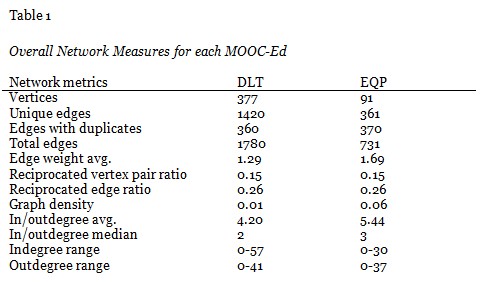
Aside from these differences, some basic patterns can be identified across both MOOC-Eds. Measures of network reciprocity, for example, are fairly similar across the two MOOC-Eds, despite the size and varied composition of educators in each network. Also, both MOOC-Eds demonstrate similar patterns in the distribution of in/outdegree. As illustrated in Figure 1, the majority of educators had support ties with three or fewer peers. There were, however, several individuals in each course with a disproportionate number of ties compared to their peers. These “core” educators will be discussed in more detail below. Finally, the edge weight measure also demonstrates that most ties between educators consisted of a single communication and a general tendency for an individual’s responses to be distributed evenly among peers.
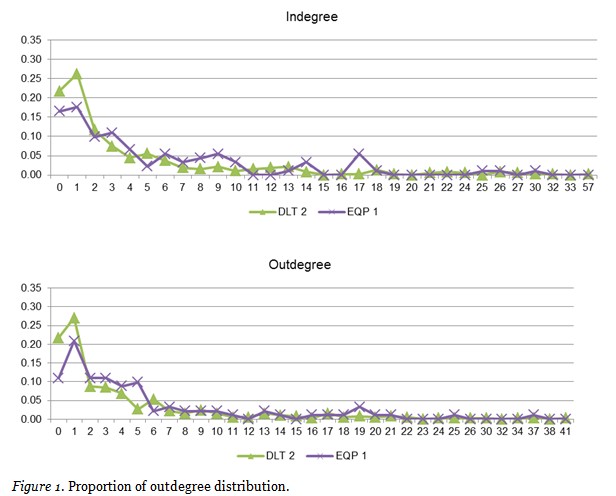
Figure 2 illustrates the combined results of these two partitions for the DTL peer support network. Solid discs represent educators identified as core to the network, while circles represent those on the periphery. In addition, all educators are blocked off into the following four simplified categories identified through blockmodel analysis: 1) Reciprocators – educators who participated in at least one mutual exchange as illustrated by the double-arrowed orange line connecting two educators, 2) Networkers – educators who were both the recipients and givers of support, though not with the same individuals, 3) Broadcasters – educators who initiated a discussion thread, but neither reciprocated with those who replied, nor posted to threads initiated by others, and 4) The Invisible – educators who responded to the postings of peers, but received no responses in return. As illustrated by the size of the block in Figure 2 and Table 2, Reciprocators made up the largest proportion of educators in both courses, and nearly all those identified as core to the network belonged to this group.
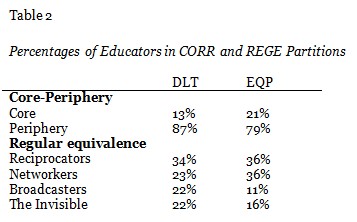
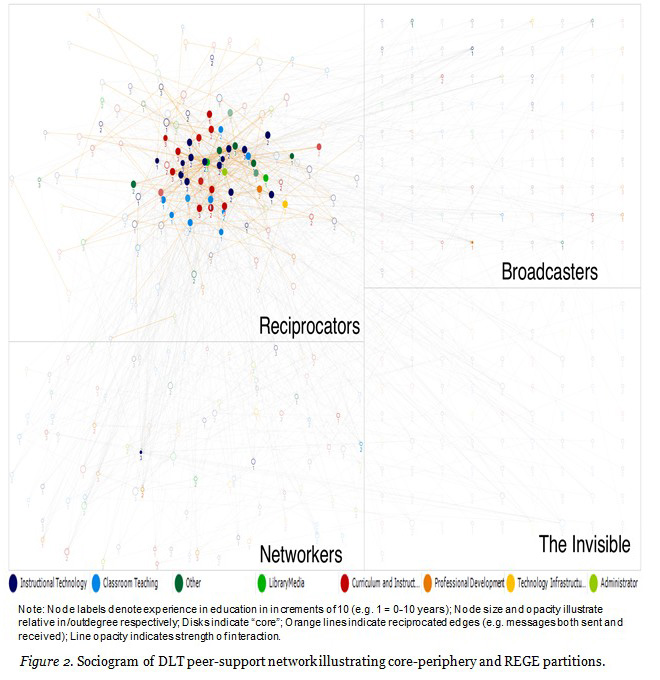
ERGM estimation results for the two MOOCs are summarized in Table 3 and show the coefficients associated with each parameter, as well as the standard error. Similar to logistic regression, which predicts a binary variable from a number of predictor variables, ERGMs predict the presence of a network tie from several parameters, with estimates indicating the importance of each to the presence of a tie (Lusher, Koskinen, & Robins, 2012). Estimated coefficients can be thus explained in terms similar to logistic regression. Positive significant coefficients indicate that the corresponding parameters in the observed network (e.g., ties between educators with the same role), controlling for all other parameters in the model, occur more than would be expected by chance, thus increasing the likelihood that a tie will occur, and vice-versa for negative coefficients. Finally, the edges term in the model is equivalent to the number of ties in the observed network and serves the equivalent function of the y-intercept in linear regression (Morris, Handcock, & Hunter, 2008).
For all models and across both courses, the comparatively large significant parameter coefficient for reciprocity indicates a strong effect and suggests that educators are considerably more likely to respond to a peer posting if they have received a prior response from that same peer. The large significant negative coefficient for popularity spread is a little less intuitive to interpret, but Lusher (2012) explains that a large, negative popularity spread, as in this case, indicates that most actors have similar levels of popularity and that the network is not centralized on indegree. Another way to interpret this is that each response an educator receives significantly decreases the probability that an educator will receive an additional response.
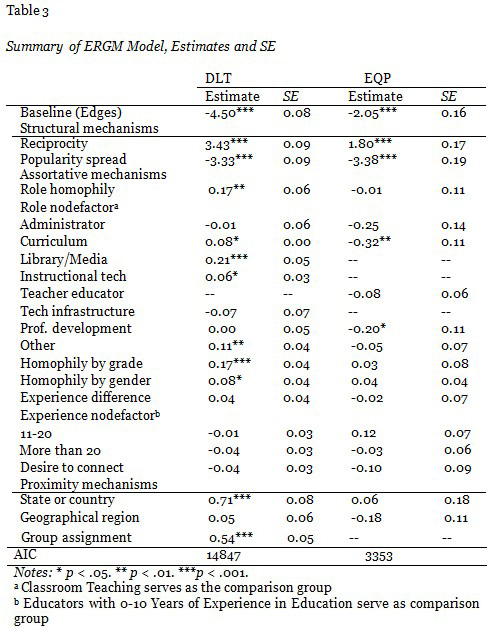
Regarding assortative mechanisms, results for homophily by role indicate a positive significant effect in the DLT MOOC, but no effect in the EQP course. This indicates that, in general, if educators shared similar roles it increased the likelihood of a support tie in the former course but not in the latter. When homophily was examined by grade levels worked with (e.g., elementary, high school), as well as by gender, the effects were again positive and significant only in the DLT course, indicating that if two educators worked at the same school level, or shared the same gender, it also increased the likelihood of a tie. A heterophily terms was also added to examine educators’ years of experience; however, the presence of ties between educators with different years of experience found in the observed network were no more than would be expected by chance.
In addition to homophily and heterophily, this model also examined the extent to which educators’ professional role, experience, or desire to connect increased the likelihood they would have a support tie with peers in the network, either on the giving or receiving end. The findings suggest that across both MOOCs, one’s professional role significantly increased or decreased the likelihood they would form a support tie when compared to classroom teachers. Regarding years of experience and a desire to connect, however, no significant effects were found, suggesting that in both cases, educators with more experience or who expressed a desire to connect were more likely to be involved in a support tie.
Finally, findings for two of the three proximity mechanisms were significant in DLT, but not in EQP. In these two courses, this indicates that educators were more likely to respond to a peer if their school or work location was in the same U.S. state or country, even beyond the effect of being assigned to discussion groups by the first letter of their state or county in DLT. This did not carry over to geographical regions, however. That is, being located in the southern states of Georgia, North Carolina, and South Carolina did not increase the likelihood these educators would respond to each other’s postings.
Results of the interaction analysis model provide insight into the extent to which discussion resulted in the co-construction of new knowledge. Coding classified each discussion thread into one of the following five categories according to the highest phase reached by the postings within that discussion.
Phase 1 - Sharing and comparing. Further the discussion by providing observations, opinions or examples that support or extend prior statements.
Phase 2 - Dissonance and inconsistency. Identify areas of disagreement or potential disagreement.
Phase 3 - Negotiation and co-construction. Explore common ground, clarify intent, seek agreement or integrate ideas.
Phase 4 - Testing and modification. Test ideas against prior information, research and/or data and proposed synthesis of ideas.
Phase 5 - Summary, application and metacognition. Summarize agreements, describe applications of knowledge or acknowledge changes in understanding.
The data, shown in Figure 3, display the proportions of total discussions by the highest phase reached. In both courses, that vast majority of discussions analyzed either remained at the level of sharing and comparing information, or entered a process in which dissonance was recognized among peers and process of negotiation or construction began to take place. However, few discussions moved beyond Phase 3.
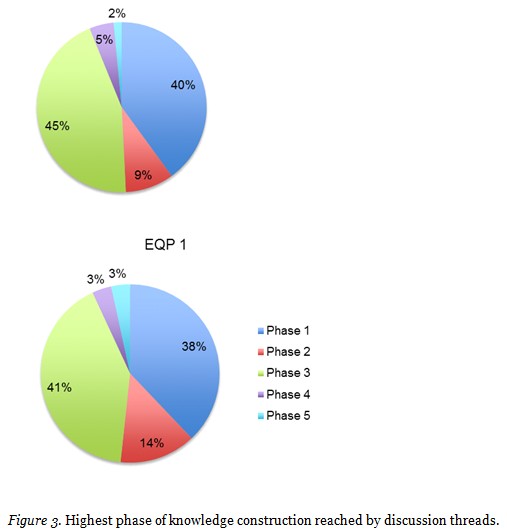
Wenger, Trayner, and De Laat (2011) describe social networks as “a set of relations, interactions, and connections… with affordances for learning, such as information flows, helpful linkages, joint problem solving, and knowledge creation” (p. 9). This study demonstrates that even with technology as basic as a discussion forum, MOOCs can be leveraged to foster these networks and facilitate peer-supported learning that results in the process of knowledge construction. However, mirroring emerging MOOC findings on steep declines in participation and course completion, both peer networks demonstrate similar drop-offs in the extent to which educators leveraged their peers. Findings on patterns of peer interaction are characteristic of online social networks in general, in which core-periphery structures, power-law degree distributions, and the prevalence of weak-ties are common (Aviv, Erlich, & Ravid, 2007; Butts, 2008; C. R. Jones, Ferreday, & Hodgson, 2008). In terms of regular equivalence partitions, these results are comparable to the findings by Wasko, Teigland, and Faraj (2009) in two online professional networks of practice. The authors reported that half of the network consisted of “outsiders” who did not receive responses, and “seekers” who received responses but did not reciprocate or pay it forward. Blockmodel analysis, however, failed to fully capture the nuances in patterning of ties. For example, while Broadcasters provided no response to their peers, many received responses from a large number of peers. In contrast, The Invisible, who despite receiving no communications from their peers, consisted of many educators who provided a disproportionately large number of responses. Finally, both Reciprocators and Networkers often skewed either towards a greater indegree or outdegree, that is, they tended to receive more support than they provided, and vice-versa.
Beyond describing the patterns of peer interaction, this study examined mechanisms that shape the structure of these networks. Several theoretical propositions drawn from the literature on social networks, online learning, and social learning perspectives were examined through ERGM analysis. Across both MOOCs, significant effects were found for the relational mechanism of reciprocity, but not for a popularity effect. Of specific interest to this study was the impact of educators’ professional roles and years of experience. Drawing from the communities of practice perspective on social learning (Wenger et al., 2011; Wenger, 1999) it was anticipated that educators in similar professional roles and settings might be more likely to interact based on a shared “domain of practice”, and that less experienced educators might seek out more experienced peers for support. However, evidence for homophily and proximity were only identified in the larger DLT course, and there was no evidence of a mentoring effect in either. The lack of homophily in EQP may be the result of the MOOC-Ed’s unique content focus, creating a specific shared domain of practice while also encouraging interaction across grade levels, negating a need to seek out others in similar roles and settings. The absence of a mentoring effect in both courses, however, may stem from the lack of what Baker-Doyle and Yoon (2010) refer to as “expertise transparency”. That is, with limited information about their peers gleaned from postings or the small handful of completed participant profiles, it may be difficult to identify experts in the MOOC. In a case study of online communities for educators, Booth (2011) suggested that network size and detailed member profiles may have played a role in cultivating knowledge sharing among educators.
Finally, findings on knowledge construction demonstrated that over half of the discussions in both courses moved beyond sharing information and statements of agreement and entered a process of dissonance, negotiation and co-construction of knowledge, but seldom moved beyond this phase in which new knowledge was tested or applied. These findings echo difficulties in promoting knowledge construction online found by several researchers (Aviv et al., 2003; Heo et al., 2010; Hou & Wu, 2011; Pena-Shaff & Nicholls, 2004). For instance, Gunawardena et al. (1997) found that interactions among conference participants as part of distance education online debate seldom moved beyond the lower phases of sharing and comparing information. Zheng and Spires (2012) found that communication between students in a graduate level education course primarily remained at the lower level Phase I stage of sharing and comparing information despite active facilitation by the instructor. It is tempting to conclude that because so few discussions reached Phase 5, there was little application of shared knowledge to the problems or issues under discussion. However, this may be the result of our interpretation of the IAM coding scheme. Practical strategies and solutions to problems or issues raised during discussion were frequently shared, but these were often coded as Phase I because they did not arise through an explicit process of negotiation and co-construction of new knowledge. Johnson et al. (2008) noted that interaction must be intentionally designed into the learning context or it is unlikely to result spontaneously. The authors of this paper contend that the same is also true for fostering knowledge construction in MOOCs.
The findings from this study also suggest several design implications for future MOOC-Eds. Kraut and Resnick (2012) have proposed numerous design claims intended to encourage contributions and exchanges in online communities, but several stand out for consideration for the design of future MOOC-Eds. Design claim 5 states that simple requests for contributions rather than lengthy or more complex ones lead to greater compliance among those who do not care strongly about contributing. In addition to the more substantive contributions such as reflective discussion prompts or detailed peer feedback, MOOC-Eds should consider providing discussion opportunities which request quick, practical information that would be of use to other educators in the community, such as requests embedded and directly relevant to content and resources provided throughout the course. Design claim 11 also states that participants are more likely to respond to the requests of others, such as with feedback on discussion postings, when they come from others who are familiar to them or more closely resemble them. One simple approach to doing so would be to request participants make public information about their professional experience and personal background gathered from the registration process via their personal profiles so peers can more easily identify each other’s professional roles, work context, and experience.
Finally, beyond just facilitating the quantity of exchanges, it is important to ensure the quality of interaction is contributing value to the community. While “quality” interaction can be defined in a variety of ways, Pear and Crone-Todd (2002) point out that meaningful interaction is not just sharing opinions and information, but should stimulate the learners’ intellectual curiosity. Likewise, social constructivists do not maintain that all conversation and discussion occurring anywhere anytime are meaningful for learning, but that discussion should be directly relevant to his/her real life and take place within a culture similar to an applied setting (Brown, Collins, & Duguid, 1989). In order to foster meaningful dialogue, Pear and Crone-Todd (2002) suggest providing guidelines for interaction, while Rovai (2001) stresses the importance of setting expectations for participation, whether in a formal social context such as an online course, or an informal context such as an online community of practice. Future MOOC-Eds will likely need to better scaffold social learning processes in order to fully leverage the potential of peer-supported learning.
Although the scope of this study was naturally constrained by funding and time, these limitations present several avenues for future research. Naturally, generalizations cannot be drawn based on two MOOCs from a single department at a university. Ideally, this study would have been comprised of numerous courses across multiple platforms to compare the networks that emerged and test the robustness of ERGMs used to model peer support mechanisms. In addition, the simplified model presented in this study was designed to examine a few theoretical propositions based on available data in aggregated form. Howison, Wiggins, and Crowston (2011) note that aggregate networks fail to capture temporal dynamics, and that replies in online threaded messages are often not a valid measure of the construct of interest, in this case “peer support”. A more complete model would have included additional relations, such as posts “read” or “liked”, as well as attributes of the postings such as timing, strength, and especially content of the postings. Finally, Edwards (2010) notes a need for a more systematic integration of SNA and content analysis, for “whilst we may divorce form from content, or structure from agency for analytic purposes, it is in that ‘messiness’ of actual social networks that they are always combined…”
Aiken, J., Lin, S., Schatz, M., & Caballero, M. (2013). The initial state of students taking an introductory physics mooc. arXiv Preprint arXiv: …, 1. Retrieved from http://arxiv.org/abs/1307.2533
Aviv, R., Erlich, Z., & Ravid, G. (2007). Randomness and clustering of responses in online learning networks. In Proceedings of the Communication, Internet, and Information Tecnology 2007. Banff. Retrieved from http://citeseerx.ist.psu.edu/viewdoc/download?doi=10.1.1.101.9151&rep=rep1&type=pdf
Aviv, R., Erlich, Z., Ravid, G., & Geva, A. (2003). Network analysis of knowledge construction in asynchronous learning networks. Journal of Asynchronous Learning Networks, 7(3), 1–23. Retrieved from http://citeseerx.ist.psu.edu/viewdoc/download?doi=10.1.1.2.9044&rep=rep1&type=pdf
Aviv, R., Erlich, Z., Ravid, G., & Trotter, R. T. (2008). Analysis of transitivity and reciprocity in online distance learning networks. Connections, 28(1), 27–39. Retrieved from https://insna.org/PDF/Connections/v28/2008_I-1_P-1-3.pdf
Baker-Doyle, K. J., & Yoon, S. A. (2010). Making expertise transparent: Using technology to strengthen social networks in teacher professional development. In A. J. Daly (Ed.), Social network theory and educational change. Cambridge, MA: Harvard Education Press. Retrieved from http://www.amazon.com/Social-Network-Theory-Educational-Change/dp/1934742805
Balch, T. (2013). MOOC student demographics (Spring 2013). Retrieved September 26, 2013, from http://augmentedtrader.wordpress.com/2013/01/27/mooc-student-demographics/
Bandura, A., & McClelland, D. (1977). Social learning theory. Retrieved from http://www.jku.at/org/content/e54521/e54528/e54529/e178059/Bandura_SocialLearningTheory_ger.pdf
Barab, S. A., MaKinster, J. G., & Scheckler, R. (2003). Designing system dualities: Characterizing a web-supported professional development community. The Information Society, 19(3), 237–256. Retrieved from http://www.tandfonline.com/doi/abs/10.1080/01972240309466
Belanger, Y., & Thorton, J. (2013). Bioelectricity: A quantitative approach. Durham, NC. Retrieved from http://dukespace.lib.duke.edu/dspace/bitstream/handle/10161/6216/Duke_Bioelectricity_MOOC_Fall2012.pdf?sequence=1
Bell, F. (2011). Connectivism: Its place in enabled learning. International Review of Research in Open and Distance Learning, 12(3), 98–118.
Booth, S. (2011). Cultivating knowledge sharing and trust in online communities for educators: A multiple-case study. North Carolina State University. Retrieved from http://repository.lib.ncsu.edu/ir/handle/1840.16/6746
Borgatti, S., & Foster, P. (2003). The network paradigm in organizational research: A review and typology. Journal of Management, 29(6), 991–1013. doi:10.1016/S0149-2063
Borgatti, S., Mehra, A., Brass, D. J., & Labianca, G. (2009). Network analysis in the social sciences. Science, 323(5916), 892–5. doi:10.1126/science.1165821
Borgatti, S. P., Everett, M. G., & Freeman, L. C. (2002). Ucinet for Windows: Software for social network analysis. Harvard, MA. Retrieved from https://sites.google.com/site/ucinetsoftware/home
Breslow, L., Pritchard, D. E., Deboer, J., Stump, G. S., Ho, A., & Seaton, D. (2013). Studying learning in the worldwide classroom: Research into EDx’s first MOOC. Research & Practice in Assessment, 8(March 2012), 13–25. Retrieved from http://www.rpajournal.com/studying-learning-in-the-worldwide-classroom-research-into-edxs-first-mooc/
Brown, J. S., Collins, A., & Duguid, P. (1989). Situated cognition and the culture of learning. Educational Researcher, 18(1), 32-42.
Burgess, S., Sanderson, E., & Umaña-Aponte, M. (2011). School ties: An analysis of homophily in an adolescent friendship network (No. 11/267). Retrieved from http://www.bristol.ac.uk/cmpo/publications/papers/2011/wp267.pdf
Butts, C. T. (2008). Social network analysis: A methodological introduction. Asian Journal Of Social Psychology, 11(1), 13–41. doi:10.1111/j.1467-839X.2007.00241.x
Cabiria, J. (2008). Connectivist learning environments: Massive open online courses. In WORLDCOMP’12, The 2012 World Congress in Computer Science, Computer Engineering and Applied Computing.
Chen, C.-J., & Hung, S.-W. (2010). To give or to receive? Factors influencing members’ knowledge sharing and community promotion in professional virtual communities. Information & Management, 47(4), 226–236. doi:10.1016/j.im.2010.03.001
Chiu, C.-M., Hsu, M.-H., & Wang, E. T. G. T. (2006). Understanding knowledge sharing in virtual communities: An integration of social capital and social cognitive theories. Decision Support Systems, 42(3), 1872–1888. doi:10.1016/j.dss.2006.04.001
Cho, H., Gay, G., Davidson, B., & Ingraffea, A. (2007). Social networks, communication styles, and learning performance in a CSCL community. Computers & Education, 49(2), 309–329. doi:10.1016/j.compedu.2005.07.003
Clow, D. (2013). MOOCs and the funnel of participation. In Proceedings of the Third International Conference on Learning Analytics and Knowledge. Retrieved from http://dl.acm.org/citation.cfm?id=2460332
Cropanzano, R., & Mitchell, M. (2005). Social exchange theory: An interdisciplinary review. Journal of Management, 31(6), 874–900. doi:10.1177/0149206305279602
Dawson, S. (2008). A study of the relationship between student social networks and sense of community. Educational Technology & Society, 11, 224–238. Retrieved from http://www.ifets.info/download_pdf.php?j_id=40&a_id=878
Deboer, J., Stump, G. S., Pritchard, D. E., Seaton, D., & Breslow, L. (2013). Bringing student backgrounds online : MOOC user demographics , site usage , and online learning. In Sixth International Conference on Educational Data Mining. Memphis, Tennessee, USA.
Dede, C., Jass Ketelhut, D., Whitehouse, P., Breit, L., & McCloskey, E. M. (2008). A research agenda for online teacher professional development. Journal of Teacher Education, 60(1), 8–19. doi:10.1177/0022487108327554
Downes, S. (2009). Learning networks and connective knowledge. In H. H. Yang & S. C.-Y. Yuen (Eds.), Collective intelligence and e-learning 2.0: Implications of web-based communities and networking (pp. 1–26). Hershey, PA: IGI Global. doi:10.4018/978-1-60566-729-4
Edwards, G. (2010). Mixed-method approaches to social network analysis. Retrieved from http://eprints.ncrm.ac.uk/842/
Empson, R. (2013). Coursera brings online instruction to teachers, taking its first steps into the k-12 market. TechCrunch. Retrieved September 27, 2013, from http://techcrunch.com/2013/05/01/coursera-brings-online-instruction-to-teachers-taking-its-first-steps-into-the-k-12-market/
Fournier, H., Kop, R., Sitlia, H., & others. (2011). The value of learning analytics to networked learning on a personal learning environment. Retrieved from http://nparc.cisti-icist.nrc-cnrc.gc.ca/npsi/ctrl?action=shwart&index=an&req=18150452
Grusec, J. E. J. (1992). Social learning theory and developmental psychology: The legacies of Robert Sears and Albert Bandura. Developmental Psychology, 28(5), 776–786. doi:10.1037//0012-1649.28.5.776
Gunawardena, C. N., Lowe, C. A., & Anderson, T. (1997). Analysis of a global online debate and the development of an interaction analysis model for examining social construction of knowledge in computer conferencing. Journal of Educational Computing Research, 17(4), 397–431. Retrieved from http://baywood.metapress.com/index/7MQVX9UJC7Q3NRAG.pdf
Handcock, M., Hunter, D., Butts, C. T., Goodreau, S. M., & Morris, M. (2008). statnet: Software tools for the representation, visualization, analysis and simulation of network data. Journal of Statistical Software, 24(1), 1–9. Retrieved from http://www.ncbi.nlm.nih.gov/pmc/articles/PMC2447931/
Heo, H., Lim, K. Y., & Kim, Y. (2010). Exploratory study on the patterns of online interaction and knowledge co-construction in project-based learning. Computers & Education, 55(3), 1383–1392. doi:10.1016/j.compedu.2010.06.012
Hew, K. F., & Hara, N. (2007). Empirical study of motivators and barriers of teacher online knowledge sharing. Educational Technology Research and Development, 55(6), 573–595. doi:10.1007/s11423-007-9049-2
Hou, H.-T., & Wu, S.-Y. (2011). Analyzing the social knowledge construction behavioral patterns of an online synchronous collaborative discussion instructional activity using an instant messaging tool: A case study. Computers & Education, 57(2), 1459–1468. doi:10.1016/j.compedu.2011.02.012
Howison, J., Wiggins, A., & Crowston, K. (2011). Validity issues in the use of social network analysis for the study of online communities. Journal of the Association of Information Systems, 13, 380–427. Retrieved from http://james.howison.name/pubs/HowisonEtAl-JAIS-SNA-Revision.pdf
Huang, Y., Shen, C., & Contractor, N. S. (2013). Distance matters: Exploring proximity and homophily in virtual world networks. Decision Support Systems, 1–9. doi:10.1016/j.dss.2013.01.006
Johnson, R. D., Hornik, S., & Salas, E. (2008). An empirical examination of factors contributing to the creation of successful e-learning environments. International Journal of Human-Computer Studies, 66(5), 356–369. doi:10.1016/j.ijhcs.2007.11.003
Jones, C. R., Ferreday, D., & Hodgson, V. (2008). Networked learning a relational approach: Weak and strong ties. Journal of Computer Assisted Learning, 24(2), 90–102. doi:10.1111/j.1365-2729.2007.00271.x
Jones, M. H., Alexander, J. M., & David, B. (2010). Homophily among peer groups members’ perceived self-regulated learning. The Journal of Experimental Education, 78(3), 378–394.
Kabilan, M.K. (2005). Online professional development: A literature analysis of teacher competency. Journal of Computing in Teacher Education, 21(2), 51-57.
Kizilcec, R. F., & Piech, C. (2013). Deconstructing disengagement: Analyzing learner subpopulations in massive open online courses categories and subject descriptors. In LAK 13 Proceedings of the 3rd International Conference on Learning Analytics and Knowledge. Leuven, Belgium.
Kleiman, G., Wolf, M. A., & Frye, D. (2013). The digital learning transition MOOC for educators: Exploring a scalable approach to professional development.
Kraut, R., & Resnick, P. (2012). Building successful online communities. Cambridge, MA. MIT Press.
Levy, D. (2011). Lessons learned from participating in a connectivist massive online open course ( MOOC ). In Proceedings of the Chais conference on instructional technologies research 2011: Learning in the technological era (pp. 31–36).
Littlejohn, A. (2013). Understanding massive open online course (pp. 1–12).
Lowes, S., Lin, P., & Wang, Y. (2007). Studying the effectiveness of the discussion forum in online professional development courses. Journal of Interactive Online Learning, 6(3), 181–210. Retrieved from http://www.ncolr.org/jiol/issues/pdf/6.3.3.pdf
Lusher, D., Koskinen, J., & Robins, G. (2012). Exponential random graph models for social networks. Cambridge University Press.
Mak, S., Williams, R., & Mackness, J. (2010). Blogs and forums as communication and learning tools in a MOOC. In L. Dirckinck-Holmfeld, V. Hodgson, C. Jones, M. de Laat, D. McConnell, & T. Ryberg (Eds.), Proceedings of the 7th International Conference on Networked Learning 2010 (pp. 275–285). Retrieved from http://eprints.port.ac.uk/5606/
McAuley, A., Stewart, B., Siemens, G., & Cormier, D. (2010). The MOOC model for digital practice. Retrieved from http://www.elearnspace.org/Articles/MOOC_Final.pdf
Mcfarland, D. A., Diehl, D., & Rawlings, C. (2011). Methodological transactionalism and the sociology of education. In M. T. Hallinan (Ed.), Frontiers in sociology of education (pp. 87–109). Dordrecht: Springer Netherlands. doi:10.1007/978-94-007-1576-9
Pear, J. J., & Crone-Todd, D. E. (2002). A social constructivist approach to computer-mediated instruction. Computers & Education, 38(1-3), 221–231. doi:10.1016/S0360-1315(01)00070-7
Pena-Shaff, J. B., & Nicholls, C. (2004). Analyzing student interactions and meaning construction in computer bulletin board discussions. Computers & Education, 42(3), 243–265. doi:10.1016/j.compedu.2003.08.003
Penuel, W., Riel, M., Joshi, A., Pearlman, L., Kim, C., & Frank, K. (2010). The alignment of the informal and formal organizational supports for reform: Implications for improving teaching in schools. Educational Administration Quarterly, 46(1), 57–95. doi:10.1177/1094670509353180
Rivera, M. T., Soderstrom, S. B., & Uzzi, B. (2010). Dynamics of dyads in social networks: Assortative, relational, and proximity mechanisms. Annual Review of Sociology, 36(1), 91–115. doi:10.1146/annurev.soc.34.040507.134743
Robins, G., Pattison, P., Kalish, Y., & Lusher, D. (2007). An introduction to exponential random graph (p*) models for social networks. Social Networks, 29(2), 173–191. doi:10.1016/j.socnet.2006.08.002
Rocca, K. A., & Mccroskey, J. C. (1999). The interrelationship of student ratings of instructors’ immediacy , verbal aggressiveness, homophily, and interpersonal attraction. Communication Education, 48(4), 308–316.
Rossi, D. (2010). Learning relationships in online contexts: An educational response to declining rates of participation and a means of support for undergraduate students. Studies in Learning, Evaluation, Innovation and …, 7(December), 1–17. Retrieved from http://acquire.cqu.edu.au:8080/vital/access/manager/Repository/cqu:6395?sort=type%2F&a_addition_time=ThisWeek
Rovai, A. P. (2001). Building classroom community at a distance: A case study. Educational Technology Research and Development, 49(4), 33–48. doi:10.1007/BF02504946
Russell, M., Carey, R., Kleiman, G., & Venable, J. D. (2009). Face-to-face and online professional development for mathematics teachers: A comparative study. Journal of Asynchronous Learning Networks, 13(2), 17.
Russo, T. C., & Koesten, J. (2005). Prestige, centrality, and learning: A social network analysis of an online class. Communication Education, 54(3), 254–261. doi:10.1080/03634520500356394
Scott, J. P. (2000). Social network analysis: A handbook (p. 240). SAGE Publications Ltd. Retrieved from http://www.amazon.com/Social-Network-Analysis-A-Handbook/dp/0761963391
Seaton, D., Bergner, Y., Chuang, I., Mitros, P., & Pritchard, D. (2013). Towards real-time analytics in MOOCs. ceur-ws.org. Retrieved August 17, 2013, from http://ceur-ws.org/Vol-985/paper3.pdf
Siemens, G. (2005). Connectivism: Learning as network-creation. Retrieved August 11, 2013, from http://www.elearnspace.org/Articles/networks.htm
Sinha, T. (2012). Proposal of a social network analytic framework to develop a better participation model for online education platforms. Technology Review, 3(2), 3–6. Retrieved from http://www.ijetae.com/files/Volume3Issue2/IJETAE_0213_53.pdf
Stepanyan, K., Borau, K., & Ullrich, C. (2010). A social network analysis perspective on student interaction within the twitter microblogging environment. In 2010 10th IEEE International Conference on Advanced Learning Technologies (pp. 70–72). Ieee. doi:10.1109/ICALT.2010.27
Treacy, B., Kleiman, G., & Peterson, K. (2002). Successful Online Professional Development, 30, 42–49.
University of Edinburgh. (2013). MOOCs @ Edinburgh 2013 – Report # 1.
Viswanathan, R. (2012). Teaching and learning through MOOC. Frontiers of Language and Learning, 3, 32–40.
Wang, L. (2010). How social network position relates to knowledge building in online learning communities. Frontiers of Education in China, 5(1), 4–25. doi:10.1007/s11516-010-0003-4
Wang, C., & Lai, C. (2006). Knowledge contribution in the online virtual community: capability and motivation. In Knowledge science, engineering and management (pp. 442–453). Retrieved from http://link.springer.com/chapter/10.1007/11811220_37
Wang, S., & Noe, R. a. (2010). Knowledge sharing: A review and directions for future research. Human Resource Management Review, 20(2), 115–131. doi:10.1016/j.hrmr.2009.10.001
Wasko, M. M., Teigland, R., & Faraj, S. (2009). The provision of online public goods: Examining social structure in an electronic network of practice. Decision Support Systems, 47(3), 254–265. doi:10.1016/j.dss.2009.02.012
Wasserman, S., & Faust, K. (1994). Social network analysis: Methods and applications. (H. Johnston & B. Klandermans, Eds.), Book (Vol. 8, p. 857). Cambridge University Press. Retrieved from http://books.google.com/books?hl=en&lr=&id=CAm2DpIqRUIC&oi=fnd&pg=PR21&dq=social+network+analysis+wasserman&ots=HuKqrf1FS9&sig=TvzSk1RxqfY26gpOuS5LgMWvyVc
Wenger, E. (1999). Communities of practice: Learning, meaning, and identity. In R. Pea, J. S. Brown, & J. Hawkins (Eds.), Learning in doing (Vol. 15, p. 318). Cambridge University Press. doi:10.2277/0521663636
Wenger, E., Trayner, B., & De Laat, M. (2011). Promoting and assessing value creation in communities and networks: A conceptual framework. Retrieved from http://isites.harvard.edu/fs/docs/icb.topic1116077.files/Assessing Learning Communities.pdf
Wise, B. (2013). MOOC-Eds bring professional development into the 21st century. Huffington Post. Retrieved September 26, 2013, from http://www.huffingtonpost.com/bob-wise/mooceds-bring-professional_b_3991308.html
Wu, J.-H., Tennyson, R. D., & Hsia, T.-L. (2010). A study of student satisfaction in a blended e-learning system environment. Computers & Education, 55(1), 155–164. doi:10.1016/j.compedu.2009.12.012
Yin, R. K. (2009). Case study research. Retrieved from http://www.langtoninfo.com/web_content/9780521676564_frontmatter.pdf
Yuan, Y. C., & Gay, G. (2006). Homophily of network ties and bonding and bridging social capital in computer-mediated distributed teams. Journal of Computer-Mediated Communication, 11(4), 1062–1084. doi:10.1111/j.1083-6101.2006.00308.x
Zheng, M., & Spires, H. (2012). Teachers’ interactions in an online graduate course on moodle: a social network analysis perspective. Meridian, 13(2), 1–17. Retrieved from http://ced.ncsu.edu/meridian/index.php/meridian/article/view/7
© Kellogg, Booth, Oliver